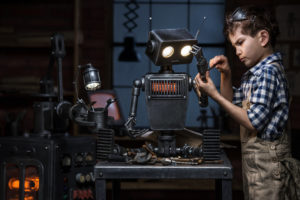
By Michael Solomon, 10x Management Co-Founder
Steve Mnuchin, U.S. Treasury Secretary, recently said in an interview that automation and AI will not be a threat to American jobs for “50 to 100 more years.” Either Mnuchin has his head in the sand or he’s a great liar — possibly, both.
It’s easy to see why Mnuchin and the Trump administration are propelling this narrative and adopting these labor policies. It shows Trump is a man of his word and that he delivers on promises he made during the election, mainly to bring back manufacturing jobs to American workers. Denying the realities of AI and automation will potentially work for the next few years, but beyond that the effects will be undeniable. And it is so shortsighted! Making the changes needed to deal with the net job loss coming will take a lot of time. It is going to push on a lot of buttons we have never had to explore previously and will be very challenging and likely divisive. The only hope we have is to get ahead of it which is why this lost time will prove to be very devastating.
The reality is that automation has already had a huge impact on the American economy. Between 2000 and 2010, it’s estimated that 4.76 million manufacturing jobs were lost to technology and automation in the United States. And that’s just the tip of the iceberg. Think about the driving industry. Almost 3% of the entire American workforce are drivers of some sort. Do you think Uber and Tesla are investing in self-driving cars for nothing? The end goal is to eliminate the driver. While this may be a few years away (but certainly sooner than 50-100 years from now!), it should be top of mind for of our government. Despite what Trump may think, this is not about trade wars or robots stealing American jobs. This is about progress. We have technology that is capable of outperforming humans at many many tasks, so companies are using it and continuing to develop it. This is also not just a blue collar problem. Many professionals will be displaced as well. Whichever side of the political divide you are on – left wing, right wing, or center – the rise of AI will have a profound effect on the workforce going forward.
Ignoring the rise of automation is like trying to revive the coal industry. The world has moved on to cleaner energy sources, but because there are still (arguably) jobs to be had in the coal industry, particularly in West Virginia and Kentucky, Trump is ensuring that no matter the impact on the environment, and no matter what direction the U.S. and the rest of the world is heading in with energy, those jobs will be created. There are 70,000 jobs left in the coal industry, while there are 650,000 jobs in renewable energy. I know that coal miners have been deeply affected by changing energy consumption, but that is simply a reality of the world. If this were 1900, Trump would be standing on a mountaintop shouting about how he is going to save the horse and buggy industry and keep blacksmiths employed. The auto industry was not a conspiracy to overtake horses. Cars are simply better at getting you from Point A to Point B. Some people are so reluctant to embrace change, and sadly for us, one of those people is the President of the United States.
Whenever the world changes, there are always people who refuse to see or accept the change. The story of Netflix founder Reed Hastings proposing a partnership with Blockbuster in 2000 comes to mind. Hastings proposed that Netflix run Blockbuster’s brand online, and was laughed out the door. We all know how that turned out.
Mnuchin saying that automation will not be a threat to American jobs for another 50 to 100 years is like Wilbur Wright saying in 1901, “Man will not fly for 50 years.” While Wright may have said this out of personal frustration after many failed attempts at flying, thankfully for him and the rest of the world, the Wright Brothers successfully flew just TWO years later. Time after time, new inventions are laughed out the door. And time after time, people are proven wrong and those inventions flourish.
When we started 10x Management in 2012, a lot of people didn’t see the growing freelance economy coming. But we believed (and still believe) that changing technology would allow particularly skilled (and highly in-demand) professionals the freedom to work in a more flexible and preferable manner. When there is a shortage of talent, people can work in ways that best suit them. Fast forward to 2017, our insights have turned out to be true. There are 45 million freelancers in the United States today, and that number is expected to grow to 60 million by 2020. The ability to foresee future trends has served 10x Management well, and we would like to see the same foresight from American labor policies. Without that foresight, the future is not looking so bright for many of us.
If you liked this article, you might enjoy reading The Real Cost of Freelancers vs. Employees